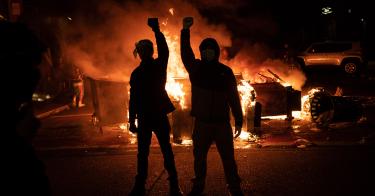This week marks the first time in living memory that widespread violence was widely viewed as a foreseeable, and even expected, outcome of an American national election. The votes are being counted just days after riots broke out in Philadelphia, causing the governor to deploy the National Guard in the largest city of a key battleground state. Since June, in fact, such scenes have been a common phenomenon in dozens of American cities.
The Transition Integrity Project (TIP), a group that has opposed Donald Trump, ran simulations that foresee disruptions caused by pro-Trump actors. “During TIP’s exercises, Team Biden almost always called for and relied on mass protests to demonstrate the public’s commitment to a ‘legitimate outcome,’ with the objective of hardening the resolve of Democratic elected officials,” the group (somewhat predictably) reported.
On the other side of the spectrum, the Texas Public Policy Foundation (TPPF) and the Claremont Institute cast TIP’s prediction as a “candid admission of the high likelihood of Team Biden encouraging street demonstrations that might spiral out of control.” The Claremont-TPPF’s own simulation concluded that left-wing street violence was a near-certainty, and accused TIP organizers of coordinating strategically with Black Lives Matter and Antifa.
In other words, both sides predict violence—but each sees the threat through its own political lens.
Last month’s arrest of 13 men accused of trying to kidnap the governor of Michigan—including an alleged white supremacist (who’s also apparently a Trump-hating anarchist)—reminds us that the threat from right-wing groups is real, as the media reminds us often and eagerly. But the sustained, often violent street actions that have been a recurring feature of American urban life in 2020 have been almost entirely driven by left-wing protestors.
>>> The Plot to Change America
And when it comes to these organizations, including Black Lives Matter, Antifa, and the newer splinter groups that mimic their tactics, the media often seems to take their social-justice posturing at face value. In the current media environment, left-of-center actors who claim to represent the cause of the oppressed are granted more moral license to use violence as a political tool.
In September, two reports were published—one shedding light on the methods and beliefs of Black Lives Matter activists, and the other analyzing the possibility that such violence will not only be sustained in coming months, but get worse.
Neither report has received much in the way of media attention, which is unfortunate, because the information they contain shows that the threat of violence won’t end with the election of a new president. In fact, all of the leading left-wing groups calling for disruptive street protests (or worse) have made demands in which they explicitly reject one or more basic elements of the American social contract that are supported by both mainstream Democrats and Republicans—including capitalism, race-neutrality, the right of a society to police itself, and even democracy itself.
US Crisis Monitor, which receives support from Princeton University, represents a collaboration between the Armed Conflict Location and Event Data Project (ACLED) and the Bridging Divides Initiative (BDI). It self-describes as a novel project that “provides the public with real-time data and analysis on political violence and demonstrations in the United States.”
In a recent report, “Demonstrations & Political Violence In America: New Data For Summer 2020,” two ACLED researchers, Dr. Roudabeh Kishi and Sam Jones, concluded that “the United States is at heightened risk of political violence and instability going into the 2020 general election,” but laid the blame for this mostly on the police. The authors’ analysis indicated that only six percent of the demonstrations that took place in the four months following George Floyd’s death had ended in riots, which is presented as good news.
But six percent of a big number is a big number. While it may be true, as the authors announce prominently on the second page of their report, that “over 10,100 of the [10,600-plus demonstration events]—or nearly 95 percent—involve[d] peaceful protesters,” that leaves more than 500 events that involved violence. Buried inside the ACLED report, as enterprising journalist Joy Pullmann of the Federalist discovered, are numbers indicating that “of the 633 incidents coded [by the ACLED authors] as riots, 88 percent are recorded as involving Black Lives Matter activists. Data for 51 incidents lack information about the perpetrators’ identities. BLM activists were involved in 95 percent of the riots for which there is information about the perpetrators’ affiliation.”
This confirmed what an informed American could already have inferred—that the demonstrations and subsequent violence were less spontaneous than the media let on, and were connected to the explicitly radical political beliefs embraced by the most prominent groups. Even the New York Times conceded in July that “one of the reasons there have been protests in so many places in the United States is the backing of organizations like Black Lives Matter,” and “while the group isn’t necessarily directing each protest, it provides materials, guidance and a framework for new activists.”
Last month, the Times’ David Leonhardt concluded that “the American right today has a bigger violence problem than the American left,” and pointed to data showing that right-wing extremists are responsible for most of America’s politically motivated killings. But, as ACLED’s data suggests, this year’s trend lines have been different. Moreover, left-wing violence is now also seen as somehow more excusable. Consider that in September, when police officers found and killed Michael Reinoehl, the fugitive who’d allegedly killed a pro-Trump protester in Portland over the summer, they’d been tipped off to Reinoehl in part by a sympathetic article by Vice reporter Donovan Farley, titled “Man Linked to Killing at a Portland Protest Says He Acted in Self-Defense.”
Another report published in September, “Network-Enabled Anarchy: How Militant Anarcho-Socialist Networks Use Social Media to Instigate Widespread Violence Against Political Opponents and Law Enforcement,” was produced by a group of seven authors, three of them affiliated with the Network Contagion Research Institute (NCRI) at the Miller Center for Community Protection and Resilience at Rutgers University (though, Joel Finkelstein, the lead author, also works for the James Madison Program in American Ideals and Institutions at Princeton). As compared with the ACLED report, the NCRI report relies more heavily on objective data analysis; and the authors don’t seek to present the data in a way that obscures the role of BLM or other groups.
Socialist and anarchist groups have created a growing online structure that serves to support violence, especially against law-enforcement, the authors conclude. Their data indicate that “the appearance of posts with anti-police outrage and/or memes and coded language increased over 1,000% on Twitter and 300% on Reddit in recent months during social justice protests.” In Seattle, groups with a radicalized collectivist agenda even managed to carve out a de facto autonomous zone for several weeks, before it collapsed into chaos and violent crime.
Common themes in the emerging constellation of radical groups include apocalyptic beliefs, a “utopian” political agenda, martyr narratives, and a cell-based organizational structure. “Many of the features of anarcho-socialist extremism seem to parallel the key tactical structures documented in libertarian-anarchist and Jihadi extremism,” they note, including the “use of memes, cloistering in fringe and private online forums, and organizing militias… These data hint that insurgent behavior, stochastic terror and even attacks on vital infrastructure may be fomenting, and even indicate the possibility of a mass-casualty event.”
None of this should be seen as obscure or controversial, since the founders of BLM—Alicia Garza, Patrisse Cullors, and Opal Tometi—typically have been candid about their anti-democratic agenda, even before the #BlackLivesMatter hashtag first appeared in 2013. Cullors, who is also a prison abolitionist and LGBT activist, has publicly stated that she and Garza were “trained Marxists,” and their rhetoric is regularly shot through with explicitly socialist ideas and phraseology (though, in keeping with the general tenor of BLM coverage, the Poynter Institute’s PolitiFact site ran a “fact-check” purporting to show that these Marxist themes are not relevant to the larger BLM movement).
In 2015, Garza appeared at a gathering of Left Forum, which holds events with titles such as “Lenin: His Work’s Pertinence Here and Now.” Garza’s own panel was dedicated to the theme of “No Justice, No Peace: Confronting the Crises of Capitalism & Democracy.” She told her audience that “it’s not possible for a world to emerge where black lives matter if it’s under capitalism, and it’s not possible to abolish capitalism without a struggle against national oppression.” This was no one-off. It’s part of her consistent message. “Black lives can’t matter under capitalism,” she told the San Francisco Weekly. “They’re like oil and water.”
In that same interview, she also chided Bernie Sanders for being weak on socialism: “It sounds like he’s been talking a lot about being a social democrat, which is still left of where the Democratic Party is, but it’s not socialism. It’s democratic capitalism… There should be more voices saying, ‘This is not actually socialism, and socialism is actually possible.’” Again, this BLM founder could not have been more clear: Not only is black liberation incompatible with capitalism, but democracy is incompatible with real socialism.
Last year, Garza told Maine progressives, “We’re talking about changing how we’ve organized this country… I believe we all have work to do to keep dismantling the organizing principle of this society.” She’s also stated that “social movements all over the world have used Marx and Lenin as a foundation to interrupt these systems that are really negatively impacting the majority of people.” These are all messages that plainly echo Lenin’s own 1917-era admonitions to the Social Democrats who urged Bolsheviks to work within Russia’s legal framework rather than simply seize power.
Cullors, similarly, reports that she learned about communism in a radical political organization she’d joined, wherein “I read, I stud[ied], adding Mao, Marx and Lenin to my knowledge.” Along with Tometi (who once traveled to Venezuela to lend her support to what she calls “a fair, transparent election system recognized as among the best in the world”), she’s publicly praised communist cop-killer Joanne Chesimard, who fled to Cuba to escape prosecution (and is now apparently known as Assata Shakur). In the same 2015 clip, filmed at a #BlogHer15 event that reportedly drew almost 2,000 attendees, the pair urged the audience to chant the communist slogan, “We have nothing to lose but our chains.”
These explicitly stated communist sympathies have an institutional component. Garza and Cullors, in particular, have worked for groups associated with the Marxist-Leninist Freedom Road Socialist Organization. Cullors trained for years at the Labor/Community Strategy Center, which Eric Mann, a former member of the Weather Underground, calls his Strategy Center the “Harvard of Revolutionary graduate schools,” and sometimes, “the University of Caracas Revolutionary Graduate School.”
Most Americans, whether Republicans or Democrats, don’t want violence. BLM’s Marxist roots and violent methods don’t reflect mainstream progressives (or Black Americans, for that matter) any more than extreme right-wing groups reflect mainstream conservatives. But one would not know this based on the skewed way that these groups are reported on. Surely, it is no slur on social justice or racial equality to point out that radical, often violent anti-capitalist, anti-democratic groups inspired by communist dictators do not have America’s best interests at heart.
If that’s something public figures aren’t allowed to say, for fear of insulting BLM and its supporters, then we have little hope of making a sustained and bipartisan moral case against street violence—not just in the shadow of this election, but in all those that follow.
This piece originally appeared in Quilette




